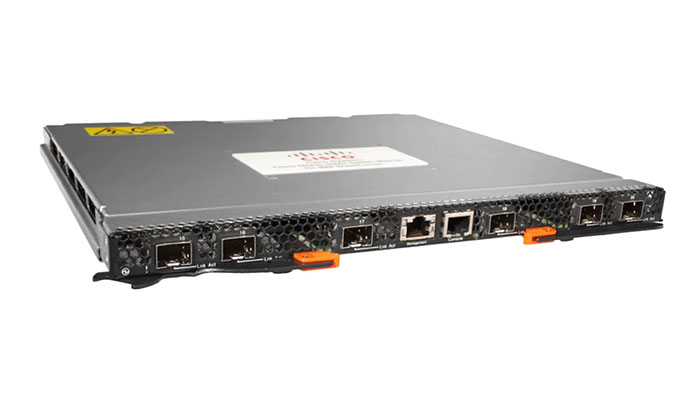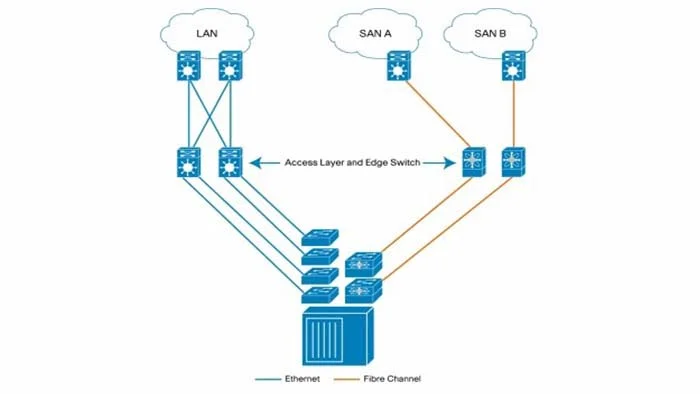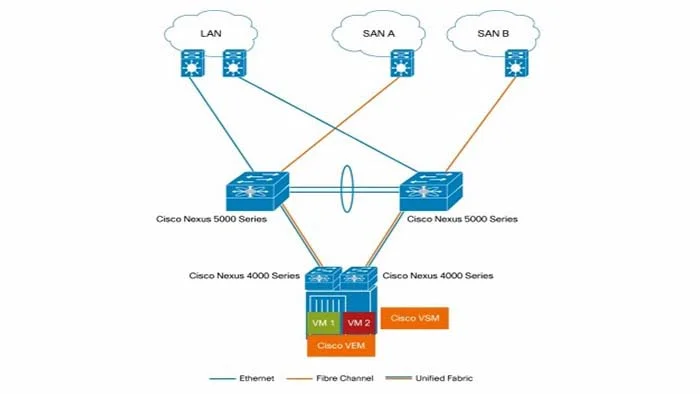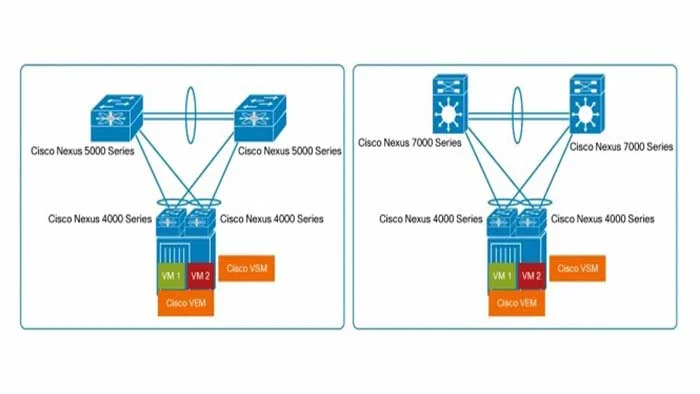Home » Cisco License » Cisco Networking » Cisco Switch License » Cisco Nexus License » Cisco Nexus 4000
This document is targeted at server, storage, and network administrators planning to deploy IBM BladeCenter servers with the unified fabric solution delivered by the Cisco Nexus 4000 Series Blade Switches. It discusses common challenges facing these administrators when deploying a blade server environment, such as management complexity, cabling, and power utilization. The Cisco Nexus 4000 Series addresses these challenges with a unified fabric solution.

To see all Cisco Nexus products, Cisco Nexus License
The growing popularity of blade servers in the data center and the focus on consolidation through server virtualization has put tremendous pressure on data center administrators to fully utilize these technologies and increase efficiency while also reducing complexity and cost in implementing these solutions. Maintaining the operational duties of each of the separate administrators is required when deploying these new blade server technologies, especially in a server virtualization environment.
Server administrators are continually consolidating their environments to reduce the number of physical servers to reduce cost and power consumption for the data center. While blade servers offer a high-density, cost-effective solution for delivering scale-out x86 architectures, they significantly increase the number of network access switches, leading to operational challenges. A reduction in Ethernet switches is needed to provide a scalable network infrastructure to meet the growing demand for these blade servers. In many cases, the LAN and SAN use different management tools and operating systems, thus providing a disjointed management infrastructure for the blade server environment.
Most organizations run parallel blade access network infrastructures for their LAN and SAN fabrics, with separate I/O switches, network interface cards (NICs), and host bus adapters (HBAs). For Fibre Channel SANs, one or more HBAs must be purchased for each server, which adds considerably to equipment costs. For mission-critical applications (and often others), most organizations provide redundant Ethernet connectivity, increasing cost and complexity even more.
These separate access networks require additional expenditures to accommodate requirements such as increased number of network interfaces, additional cabling and switch ports, and the need for more complex support. Another factor that increases the number of network adapters needed is server virtualization. Server virtualization, such as that provided by VMware, requires multiple adapters to carry traffic for LAN, SAN, hypervisor management, and virtual infrastructure services.
To meet these challenges, organizations must build a single network infrastructure that unifies traditional blade server I/O, storage, and network operations to more efficiently support evolving business applications. Cisco continues to lead and evolve the data center with its next-generation unified fabric blade switch for IBM BladeCenter customers the Cisco Nexus 4001I Switch Module for IBM BladeCenter.
The Nexus 4001I unified blade Cisco switch for the IBM BladeCenter chassis offers these critical benefits:
– 14 downlinks: Used for each blade server in the IBM BCH or BCH-T chassis; use Gigabit Ethernet and 10 Gigabit Ethernet autosensing
– 6 uplinks: Used for connectivity to upstream switches with Gigabit Ethernet and 10 Gigabit Ethernet autosensing

For more Cisco Switch Products, Cisco Switch License
With the increasing consolidation of the data center through server virtualization technologies such as VMware ESX, Microsoft Hyper-V, and Citrix Xen, physical servers are now requiring more bandwidth. As server, CPU, and memory technologies that facilitate server consolidation become more advanced, a strong infrastructure foundation is a necessity. With the standardization of FCoE, Cisco led the industry with the introduction of the Cisco Nexus 5000 Series Switches top-of-rack (ToR) access switch platform. With data centers deploying more blade server technologies, Cisco again leads the industry with the first unified fabric Ethernet switch built for the blade server platform, the Cisco Nexus 4000 Series, which extends the benefits of the Cisco Nexus Family to the x86 blade server access layer.
In today’s data center, blade chassis solutions require a multitude of different network switches. A typical blade chassis has two to four Ethernet switches and two Fibre Channel switches for block-level storage access. The number of cables required and the operation of these switches can become extremely difficult to manage as blade servers become more prevalent in the data center (Figure 1).
Cisco Nexus 4000 Series Consolidated Solution The Cisco Nexus 4000 Series, in conjunction with the Cisco Nexus 5000 and 7000 Series, provides a consistent management solution with the Cisco NX-OS operating system for both LAN and SAN administrators.
The Cisco Nexus 4000 Series is a single application-specific integrated circuit (ASIC) platform with a cut-through architecture that has extremely low latency to provide increased application performance for virtualized environments. With nonblocking 10 Gigabit Ethernet bandwidth for every port on the Cisco Nexus 4000 and 5000 Series, the Cisco Nexus platform enables consolidation for unified I/O for the blade server environment. Consolidating the fabric reduces the number of actual modules required in the blade chassis, thus reducing cabling needs and power consumption.
The Cisco Nexus 4000 Series also provides the capability to set the uplink ports to Gigabit Ethernet in cases in which the upstream switch does not have any available 10 Gigabit Ethernet ports.
Cisco also offers Cisco Nexus 1000V, which can be inserted into the VMware server virtualization environment to achieve an end-to-end Cisco Nexus solution for the virtualized environment in the blade server.
In addition, Cisco Data Center Network Management (DCNM) provides a single point of management across the entire data center for all Cisco Nexus platforms. Cisco DCNM can manage multiple Cisco Nexus 4000 Series switches from a centralized management interface, simplifying deployment and configuration of the Cisco Nexus switches.
The transformation of the data center into a unified network can occur incrementally within existing environments, reducing disruption for the organization while helping ensure optimal benefit and investment protection. In the initial phase, the access layer should be the area of focus, with Cisco Nexus 4000 and 5000 Series unified access layer switches providing a unified fabric for LAN traffic, IP-based storage traffic, and Fibre Channel-based storage traffic.
After the lossless 10 Gigabit Ethernet infrastructure for the blade server is in place, customers can deploy a unified fabric, which provides the flexibility to run FCoE, NAS, and iSCSI, or a combination of these technologies.
Organizations considering FCoE as a solution do not have to wait for native FCoE storage; they can roll out a lossless 10 Gigabit Ethernet infrastructure with FCoE between the converged network adapter (CNA) and a ToR switch such as the Cisco Nexus 5000 Series with a Cisco Nexus 4000 Series switch at the access layer and gain most of the cost savings from the use of fewer adaptors, cables, and switch ports. This FCoE connection between the CNA and the Cisco Nexus 4000 and 5000 Series switches will carry both Fibre Channel and Ethernet traffic on a single link. The Cisco Nexus 5000 Series switch will then separate LAN and Ethernet traffic to the Cisco Nexus 7000 Series switch upstream and SAN traffic to the Cisco MDS 9000 Family switch upstream.
FCoE provides a mechanism for carrying Fibre Channel traffic over lossless Ethernet. Fibre Channel and FCoE will coexist for years to come and are complementary technologies; FCoE uses the existing Fibre Channel management infrastructure, thus providing investment protection.
FCoE can enhance server virtualization projects by enabling greater virtual machine mobility. Even in a virtual environment, there are still physical interfaces beneath the hardware that have to be provisioned properly. The simplified cabling schemes provided by FCoE can reduce the amount of physical work required to move a virtual machine from one server to another. If a virtual machine has fewer connection points, it will be more mobile. Figure 2 shows the benefits of this unified virtualized solution.

Some data center deployments of IBM BladeCenter servers may not have any access to SAN storage. These deployments rely on IP-based storage access, such as Network File System (NFS), Common Internet File System (CIFS) or iSCSI shared storage. The combination of the Cisco Nexus 4000 Series and the Cisco Nexus 5000 or 7000 Series provides consistent management with Cisco NX-OS and a highly resilient design topology with virtual PortChannel (vPC) capabilities. Figure 3 depicts the topology for a highly available solution with the Cisco Nexus 4000 Series.

The Cisco vPC feature on upstream switches link Nexus 5K uses all available links in the virtual PortChannel, thus providing more bandwidth and redundancy in case of failure of the upstream switch. The most important benefit of vPC is that it removes the need for spanning-tree protocols, since the two upstream switches act as a single switch. With advanced capabilities including eight virtual lanes, role-based access control (RBAC), link-state tracking (LST), Rapid Per-VLAN Spanning Tree Plus (RPVST+), consistent low latency, and many other Ethernet features, the Cisco Nexus 4000 Series provides a robust and highly resilient solution for the IBM blade server environment.
With the introduction of the Cisco Nexus 4000 Series Blade Switches, Cisco continues to lead the industry in providing high bandwidth, rich Ethernet features, unified I/O, and consistent management to the data center. Customers continue to reduce operating expenses (OpEx) through data center consolidation, and the Cisco Nexus 4000 Series facilitates this consolidation by reducing the number of switches and cables and the amount of power needed in the blade chassis. Providing a 10 Gigabit Ethernet switch to the server for an Ethernet-only or unified I/O solution, the Cisco Nexus 4000 Series helps end user’s move toward a 10 Gigabit Ethernet network.
NOTE: This product is no longer being sold.
View the End-of-Life Notice to learn:
Designed for third-party blade servers
The 4000 Series switches extend the benefits of the Cisco Nexus Family to blade servers. The series addresses the challenges of having more switches and cables in a single chassis, implementing virtual machine mobility, and meeting high bandwidth and power requirements. These Fibre Channel over Ethernet (FCoE) switches are fully compliant with the IEEE Data Center Bridging specification.
Low TCO
Unified Fabric with the Cisco Nexus 4000 on the blade server access allows a significant reduction in the number of switches, network interface cards and in power requirements.
High performance
Purpose built with Unified Switch ASIC, Cisco Nexus 4000 is a line-rate, extremely low latency switch. All ports support Gigabit Ethernet and 10 Gigabit Ethernet autonegotiation for increased investment protection.
Enhanced server virtualization
Unified Fabric with the Cisco Nexus 4000 provides uniform server interfaces, and simplified cabling enhances VM mobility.
Increased resilience
Cisco Nexus 4000 extends NX-OS to blade server access, providing a single modular operating system across the data center.
Cisco Nexus 4000 Series try to enhance the of infrastructure and applications management in companies and corporate networks. It gives the access layer infrastructure to its trustworthy users. Indeed there are different ways to contact us and order. The customers should proceed from Cisco License price quote to order and link to our experts to give them the best information and guidance. Our experts give the accurate information to the customers to buy related products and licenses.
"*" indicates required fields